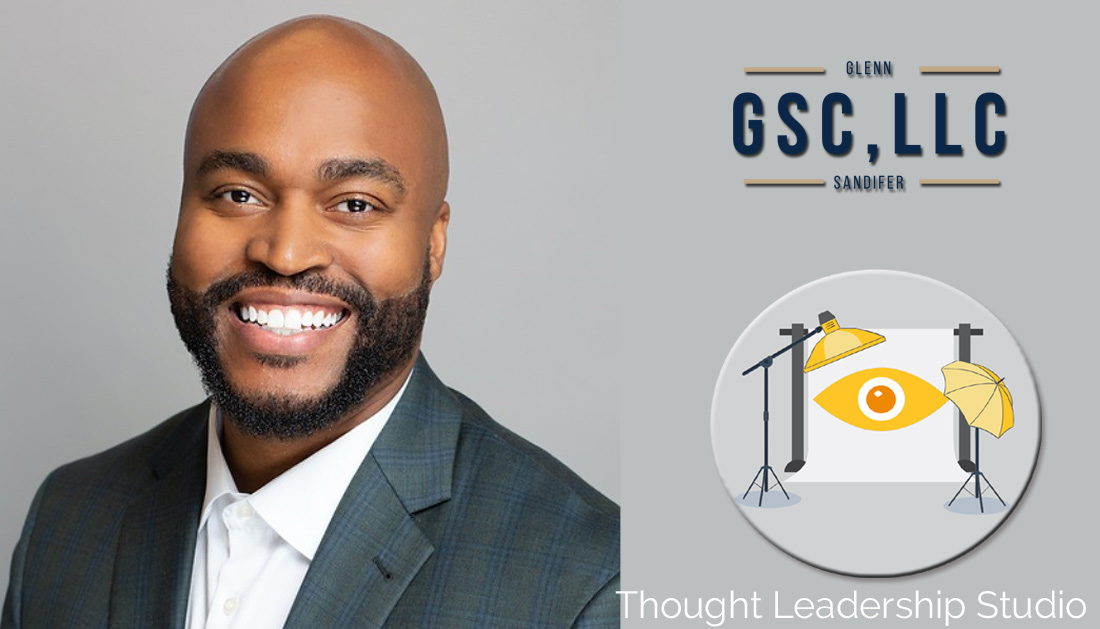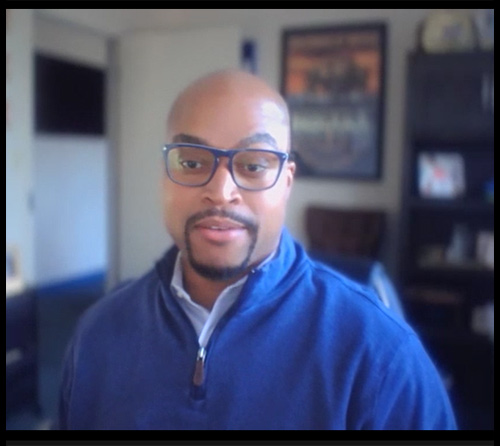Thought Leadership Studio Podcast Episodes:
The Power of Authentic Leadership with Glenn Sandifer
Episode 97 - Leading with Integrity and Vision: How Glenn Sandifer Transformed His Career through Authenticity, Measurable Goals, and the Visible Expert Phenomenon

#authenticity, #businessdevelopment, #empatheticleadership, #goals, #influence, #leadership, #linkedin, #marketing, #networking, #personalbranding, #sales, #strategicthoughtleadership, #thoughtleadership, #thoughtleadershipmarketing, #valuesbasedleadership, #vision
Or Click here to listen or subscribe on appWhat this episode will do for you
:- Glenn Sandifer's Leadership Journey: Learn how Glenn's career path, including pivotal moments like layoffs and his rise in the security industry, highlighted the importance of authenticity and vulnerability in leadership.
- Translating Vision into Actionable Goals: Discover how to break down a big vision into measurable, realistic goals and the role of drive in achieving success.
- The "Visible Expert" Phenomenon: Explore the power of becoming a visible leader in your industry, and how that contrasts with "hiding behind a logo".
- Leveraging Social Media for Business Growth: Gain strategies for using LinkedIn and Sales Navigator to create meaningful connections, share your expertise, and convert relationships into business opportunities.
- The Importance of Building Authentic Relationships: Learn why surrounding yourself with the right people and being true to your authentic self is key to personal and professional success.
Glenn Sandifer.
In this episode, I’m excited to introduce Glenn Sandifer, Senior Director at Securitas Technology US, and an expert in leadership and business development.
Glenn’s journey from overcoming layoffs to building his career in the security industry is a testament to the power of authenticity in leadership. He shares how translating a vision into actionable goals and leading with vulnerability can build trust and drive success.
We also discuss the "Visible Expert" phenomenon, it's relevance in today's attention economy, and how platforms like LinkedIn and Sales Navigator can help build thought leadership and drive business. Glenn’s insights on setting realistic goals and leveraging social media to expand your influence are invaluable
Some of Glenn's coordinates:
Curated Transcript of Interview with Glenn Sandifer
The following partial transcript is lightly edited for clarity - the full interview is on audio. Click here to listen.
Chris McNeil: I'm your host, Chris McNeil with Thought Leadership Studio, and I'm sitting across Zoom with Glenn Sandifer, senior director at Securitas Technology us.
Glenn brings over 20 years of experience in inside sales and client success backed by an MBA in project management. His expertise spans driving strategic growth, operational excellence and change management initiatives. And of course, thought leadership is all about change.
Glenn has a strong background in CRM, migrations, sales enablement, and successfully integrating teams after the acquisition of Stanley's security. He's also a published author, frequent podcast guest sharing his insights on the security industry industry in general, and its evolving challenges. Great to have you here, Glenn. .
 Glenn Sandifer: Thanks Chris. Thank you for the introduction and thank you to your audience for their time. .
Glenn Sandifer: Thanks Chris. Thank you for the introduction and thank you to your audience for their time. .
Chris McNeil: My pleasure.
So to give our audience a little background and context, we usually start with a question around Pivotal events.
Was there a pivotal event or a shift in your life or an awareness or awakening of some sort that sets you on the path to bring where you are today in doing what you're doing now?
Glenn Sandifer: So is there something that was pivotal?
Rebuilding After the Fall: From Layoff to Leading Change
It will probably be my second big layoff.
And the layoff was more, it wasn't called a layoff, but I don't believe in fake words. I believe in words that actually have meaning. I was packaged out, so at the time I was working for ADT's largest dealership. My wife and I had just relocated to Nashville, Tennessee where we live, and after two months they did a restructure.
That restructure led to my team and a large portion of the people that I supported from an inside standpoint marketing and digital marketing to be let go. Two months later we heard rumblings of a sale and then a year and a half later the sale was completed. So we were just kind of the next phase of cutting costs and it wasn't a really good fit. So I'm fine with that. But that led me to start my second accidental coaching and consulting company, which was Glen Sander for consulting out of Tennessee.
 And there I ran around like a madman in 2018, building out network, building out relationships without the benefit of being from the market and just doing it the old fashioned way, knocking doors, picking up the phone, calling on businesses, attending BNI and the Chamber of Commerce meetings. And that created a new version of grit that I had not yet tapped into. And so I did that for a couple of years and then I up a couple of contracts in the builder space, the security space, referral partner marketing, and it led me to catch the attention of then Stanley Electronics.
And there I ran around like a madman in 2018, building out network, building out relationships without the benefit of being from the market and just doing it the old fashioned way, knocking doors, picking up the phone, calling on businesses, attending BNI and the Chamber of Commerce meetings. And that created a new version of grit that I had not yet tapped into. And so I did that for a couple of years and then I up a couple of contracts in the builder space, the security space, referral partner marketing, and it led me to catch the attention of then Stanley Electronics.
So Stanley electronic security was based out of my hometown of Indianapolis, Indiana, but Stanley would've never hired me if I was in Indiana, is what I always used to joke. They wanted people from other markets that they seemed as more sexy or attractive. And so I ended up on their radar through the former VP of HR.
She was stalking me, she was seeing my content, she was seeing the work that I was doing and said, I think we need a guy like that who's well versed. And so I had a conversation with then the hiring manager, and that was, now we're in 2020. So I let 2020 expire all of my contracts. I shut down my practice and I went full time back into the security space with Stanley Security. That was a great decision, but it would not have happened if I did not have the layoff experience and I did not have the grit and the drive to go out and make something happen.
And from there with Stanley, I scaled a team from six to 60. After it was scaled to 60, they announced the acquisition by now our parent company and with our parent company. I've had the privilege the last two years to serve on the North American leadership team providing insights around strategy and change management.
The Power of Authenticity in Networking: Building Meaningful Connections
Chris McNeil: That's awesome. And I picked up a couple of threads I think would be interesting to our listeners, one of which is: "As one door closes, another one tends to open, but not always without looking for that door, sometimes we push against the wall and don't see the door over there."
But you were looking for the door and doing some feet on the street kind of networking. What did you learn from that that might be helpful to our listener who could also benefit from that type of networking?
Glenn Sandifer: Rapport building is a big part of relationship management, and so I think it's easier to quote, have a network in your hometown or your home region. If you went to college in Columbus and you stayed there and worked, you can always tap into your network through the university network. We didn't have that luxury.
 The luxury for me was I had energy and I had drive, and I had a wife I was trying to support. So I said, I cannot be down for long because even though we have an emergency fund, I don't want to tap into it. So let's get out here and let's get to work. But what I learned is that people weren't really interested in what I was selling. They were interested in me and they were interested in what type of connection I was able to share with them through authenticity.
The luxury for me was I had energy and I had drive, and I had a wife I was trying to support. So I said, I cannot be down for long because even though we have an emergency fund, I don't want to tap into it. So let's get out here and let's get to work. But what I learned is that people weren't really interested in what I was selling. They were interested in me and they were interested in what type of connection I was able to share with them through authenticity.
So I have tried to drive both my consulting practice at that time and now serving in two various leadership capacities to lead with authentic self is the word. My authentic self. Everywhere I go, whether it's church, whether it's home, whether it's in the business on a zoom call, doesn't matter. I try to give people the real version of me so they're not caught off guard.
So I think that being authentic, it led to being invited to from black chamber to Nashville Chamber, from Nashville Chamber to Greater Tennessee Chamber from that for BNI and then BNI to connect Nashville, Toastmasters, et cetera. So I looked up and by December of 18 when this happened, I'd had a network and I'd had 151 to one-to-ones. I had a network of around 300 people, and it was all kind of overwhelming. I was like, what do I do with it?
And so then I just went back to my authentic self and I was like, Hey, I need help. Okay, what do you need help with? I'm need a contract. I need a $5,000 contract to get me through the next two months. I'll find one for you. And then three hours later, alright, I'm going to put you in contact with this business owner. They're actually migrating their CRM, Hey, I need help. What? I need a referral partner that's going to deliver leads for solar, that's going to deliver leads for home security two hours later. Alright, I got a guy that's perfect that's in the market, he's actually close to you. You guys meet for coffee. I was able to kind of just string all those together into success.
Chris McNeil: That's awesome. And leading with your authentic self is powerful. I was going to ask, what specifically do you mean by that? And you kind of preemptively answered part of it in being vulnerable.
What else would you say about leading with your authentic self?
Glenn Sandifer: I mean, it's vulnerability. And then the second thing I would say about authenticity is you first have to know who you are. I'm an author, I wrote books. And one of the first things that I say in that book series is you have to know who you are.
So I can't show up to a meeting with you, Chris and try to be a guy named Jim that I can't project and be my boss because I am not my boss. I'm not as good as my boss, I'm not as good as my boss's boss. So I have to show up in a manner and in a way that really, I guess would say is humble.
If you're the smartest person in the room, you're in the wrong room unless you're in a room with my boss and his friends because they're all smart and they all challenge each other and question each other with respect, with the intent of driving business and driving whatever their initiatives are forward. But I would say that would be the case.
And honestly, I think the word would be humility. You have to be humble enough from a vulnerability standpoint to accept the support and then take the questioning on what you would be able to do to help drive change.
Acquiring Self-Knowledge: How to Truly Know Yourself Through Reflection and Relationships
Chris McNeil: How do you know if you truly know yourself or not?
What's the evidence of that or how would you recommend the listener start to create whatever kind of inventory to assess well, am I being myself or knowing myself?
Glenn Sandifer: Well, I mean the easy answer and that I can give is, I mean people who follow my content and know me that I'm a Christian. So as an authentic Christian, my life is reflected against the life of Jesus. And the guide for that is the Bible. So it's actually through my lens a lot easier to know where I shape up. Because if I am not looking like Jesus, if I'm not loving my neighbor as I love myself, if I'm not giving to the poor, if I'm not giving back, if I'm not being an excellent communicator and leading with love and leading with humility, then I don't look like him.
 But for someone that's in your audience as far as knowing yourself, I would say that you are going to be the combination of your six closest people, not closest friends, closest people, your mom, your dad, your sister, your brother, your children, your spouse, and then your best friend all know you. So if you don't have a relationship there or one of those don't qualify for you, take that out. And then you add another significant person, they would be able to, those people should be the ones that will be the check for you about where you stand and where you are.
But for someone that's in your audience as far as knowing yourself, I would say that you are going to be the combination of your six closest people, not closest friends, closest people, your mom, your dad, your sister, your brother, your children, your spouse, and then your best friend all know you. So if you don't have a relationship there or one of those don't qualify for you, take that out. And then you add another significant person, they would be able to, those people should be the ones that will be the check for you about where you stand and where you are.
In my marriage and my relationship, my wife knows when I need a break and I'm not taking it. She's the one that says, all right, I need you to break. I need you to be on PTO next Thursday because you need a break. Nope, I got the kids. You don't have it. My kids, my daughter love her to death. Two years old as of this recording Daddy something wrong. And I'm like, what do you mean it's something wrong? I'm like, yeah, something's wrong. What's wrong? I was like, nothing. I just needed a hug and kiss baby. It's just like, okay, so I'm wearing what I'm experiencing to where she can pick it up. Then my son goes silent. He's like, I'm not talking to you. You're not my best friend. Okay, what did I do? Oh, I know what I did. I was short with him five minutes ago and he's punishing me for why was I short? Because I'm dealing with X.
So I think those three examples are just good checks. And then what I talk about for the times, not now, but that I've coached and consulted, is as I talk to young men, I like to say, who's in your pack? 18 to 33 is going to be your most important developmental years that set up 34 through 60. And who you're hanging out with and what you're doing and what you're consuming and what you're transacting with will lead you to the result at 33 where you'll ask the question, how did I end up here?
You ended up here because you were with Tom, you were with Harry, you were with Sam, and they weren't about anything. They didn't have any vision, they didn't have any goals, they didn't have any drive. And so that rubbed off on you and your people who are close to you would be able to communicate that. But I've surrounded myself with a really strong tribe of men first that are driving towards commonality goals as Christians, as husbands, as fathers, and as business leaders and or small business owners.
And so we are able to have conversations at a much higher level about in a more granular level, where we don't get offended when we question and challenge each other. Glenn, tell me about why you're thinking that that would be the best move. And we talked through it and I was like, have you considered, can you consider this? Have you thought about how this would go and it turn this way if it doesn't work out? What is your plan?
Vision, Goals, and Drive: the Blueprint for Creating Your Future
Chris McNeil: So having the reflection back from people that you're close to calibrate where you're at, perhaps choosing the people that you surround yourself with. And you mentioned vision, goals and drive are those values that are important to you?
Glenn Sandifer: Yeah, vision, goals and drives. So where there is no vision that people will perish, I believe that you have to have a vision of what you want your life to be. And one thing that I've lived by and that I stress on, where do you want your life to be at 60? In previous life, we made decisions. And most people make decisions on what they want at 16.
 So if you look at the prolonged adolescence we have in the workplace right now, a lot of people are still thinking about life as a 16-year-old. So if you have no vision as at the age of 60, I want to have a fully funded retirement. I want to have one or two small businesses, I want to be able to spend time traveling with my spouse and I want to spend time with grandkids, how do I get there?
So if you look at the prolonged adolescence we have in the workplace right now, a lot of people are still thinking about life as a 16-year-old. So if you have no vision as at the age of 60, I want to have a fully funded retirement. I want to have one or two small businesses, I want to be able to spend time traveling with my spouse and I want to spend time with grandkids, how do I get there?
So then you kind of back into the steps, what does 50 look like? What does 40 look like? What does 30 look like? And then you realize, okay, at 38, I don't have that much time to get to 60. I got to get to work, and I got to get busy on the assignment that I have. So vision is very important. Drive is important because lazy people don't eat. It's just that simple.
If you're lazy and you're unwilling to put in the hours to learn a craft, put in the hours to execute and perfect that craft and then put in the hours to be around people who are smarter than you and drive value for clients or end users, you're never going to get ahead. So if you have zero drive, which I think in some instances and on some podcast, people are saying, oh, drive is not needed. No, you need drive because the market wherever you live right now, depends on people driving it forward. Meta's not sitting back waiting on you to figure out if you want to come to work today .. Meta's going to drive it forward with or without you. And the people who are willing to drive are going to take Meta to the next level.
Chris McNeil: That's right. Best way to predict the future, to create it.
Glenn Sandifer: Create it.
Aligning Vision and Goals: Breaking Down Big Ambitions into Achievable Steps
Chris McNeil: Yep. Or design it. How do you see the relationship as a leader and as someone who helps other people with leadership between vision and goals, how do you translate a vision to goals and how do you make those goals meaningful and set 'em up in a way that creates a feeling of success along the way?
Glenn Sandifer: So communicating to vision, to goals. So let's do a simple one. I think people will appreciate. So I have a vision to be the top sales rep within my company. Our company sells X product. The questions I'm going to ask, what is the average deal size? And they'll say, oh, the average deal size is $250,000. Okay, what was the top rep, the top five reps?
What did they bring in on average in the last three years? I don't know. Well, you have no vision. If you want to be the top sales rep, I can't create any goals for you. So then they come back and they say, all right, the top sales reps last year we're at 10 million, 9 million, 8 million, seven and a half, seven and a half, with their average deal size of two 50. How much did they make? Okay, they made that.
 So how many widgets do you need to sell or service bundles? Do you need to sell X? What's your close rate? Oh, my close rate is a quarter every percent. Alright, so let's divide that by four by 0.25. Let's see. This is how many deals you need to close for that year. How do you calculate how you get your deals? What do you mean? So then we say, let's just say the number's a thousand. You need a thousand deals to get a thousand deals or get one deal that takes 10 appointments. Of those 10 appointments, those 10 appointments have to lead to six opportunities. And those six opportunities, one will close. So you're going to need 6,000. You're going to need 6,000 appointments this year in order to hit that number.
So how many widgets do you need to sell or service bundles? Do you need to sell X? What's your close rate? Oh, my close rate is a quarter every percent. Alright, so let's divide that by four by 0.25. Let's see. This is how many deals you need to close for that year. How do you calculate how you get your deals? What do you mean? So then we say, let's just say the number's a thousand. You need a thousand deals to get a thousand deals or get one deal that takes 10 appointments. Of those 10 appointments, those 10 appointments have to lead to six opportunities. And those six opportunities, one will close. So you're going to need 6,000. You're going to need 6,000 appointments this year in order to hit that number.
Is that something that you can accomplish? Well, no. Well then maybe being the top rep is not the goal this year. Maybe being the mid-tier rep is, and being in the six through 10 is more attainable because last year you were only at 3 million and looking at some of the deals, they had large white wells that were able to deliver and take them from 5 million to 10 million.
So looking at it from a vision standpoint and then saying, if I want to be the top guy, look how realistic it is. I mean, vision aligns with goals, but goals have to be realistic. They have to be measurable, and they have to be attainable.
Chris McNeil: Well, a lot of people miss the point of understanding exactly where you're at relative to your goal. You set a goal, but they don't think about "where I'm at".
Glenn Sandifer: When you set a goal, you have to think about, you typically think about the outcome. And I tell people all the time, and I teach this in my own life and in my relationships, what is the outcome you're trying to achieve? Well, this is the outcome I'm trying to achieve. Okay, what inputs based on the market will lead to that output?
And then we go through the inputs. Which of those inputs are you doing today? None. Which of those inputs are you willing to start? One, then you're not going to get the outcome. But if it takes five inputs to get it with consistency, it's going to take you probably two or three times the amount of effort to get it done until you decide to do the work.
From Invisible to Visible: the Power of Thought Leadership in Today’s Attention Economy
Chris McNeil: Absolutely. And accordingly, where does it come in to actually look at the process? Because in working with sales, we can run numbers and use assumptions about conversion ratios to come up with predicted activity levels necessary to get to a goal, whereas also looking at, well, "Is this the most effective sales process? Is there maybe a better way?"
Now I've seen a lot of migration working in Strategic Thought Leadership towards more inbound type sales rather than outbound efforts or finding the right balance between those.
And some have called it the "visible expert phenomenon. I actually had a guest who wrote a book who was a coauthor of a book by that name, where now, as opposed to 40 years ago, a fewer leader in a company, you're expected to be visible, you're expected to have a LinkedIn presence, and you're expected to communicate with an audience.
And part of that is it builds credibility and it gives you an opportunity to lead to thinking of the marketplace. And sometimes that creates more sales that seem to come out of nowhere, but they're really coming from the leadership that you brought to the marketplace. How would you speak to that phenomenon?
Glenn Sandifer: Well, I think and you said the title was invisible ...
Chris McNeil: The Visible Expert Phenomenon (actually, it's "Revolution")
Glenn Sandifer: So going from invisible to visible because visible, we never knew who the CEO of Pepsi or Kellogg was. We knew Ford because it was the Ford family, but we would have to wait until the newspaper came out or Wall Street Journal, God, I guess I'm dating myself. Whereas we would see who the CEO was of a company or who were the leaders.
But I think the visible expert really, I mean to back up, we are in an attention economy.
Chris McNeil: Yes.
Glenn Sandifer: So the more attention and eyeballs you're able to gather, the higher your conversion rate or activation rate can be for a product good or service and brands and agencies and individuals are looking for that. So if you're a visible leader, if you're a visible expert in a space, I believe that it does drive business.
But that business goes unaccounted what we see through tools like LinkedIn and Sales Navigator trying to capture that attention and then transact that and convert that into dollars and a pipeline value. I have been fortunate to be a part of personally the sales navigator experience since the beginning. I was one of the first super users. Loved it. They flew me out. I flew into Oakland like an idiot, and then I had to take a car all the way around to get to believe it was Mountain View. It was one of those cities, mountain View, outside of Cupertino.
 And it was just a day trip. And they took us around the campus, they let us see all these things, and then they showed us all of the features that are now available through Sales Navigator, some of the features that have been discontinued, sales insight. But all of that meeting was around helping them understand how do we use LinkedIn and Sales Navigator to drive business. And I had a very easy case study because I said, okay, for my role as associate for business partnerships for AD T's largest dealer, I got to bring on 30 new referral partners this year. Ask me how many I've brought on so far, how many? 48, what how'd you bring on 48? 48 that are producing RGU or revenue generating units for the business each month?
And it was just a day trip. And they took us around the campus, they let us see all these things, and then they showed us all of the features that are now available through Sales Navigator, some of the features that have been discontinued, sales insight. But all of that meeting was around helping them understand how do we use LinkedIn and Sales Navigator to drive business. And I had a very easy case study because I said, okay, for my role as associate for business partnerships for AD T's largest dealer, I got to bring on 30 new referral partners this year. Ask me how many I've brought on so far, how many? 48, what how'd you bring on 48? 48 that are producing RGU or revenue generating units for the business each month?
And it was through Thought Leadership I was sending out, this was the time of infographics showing why defenders, why a DT, why become a business partner, testimonials from former or current business partners about how this exploded their revenue and how the cross sale opportunity created a better quality of work-life balance for the team members.
They could depend on being able to get that money back. And then we ran every time we launched, we ran contests and we did videos before video was a thing. And we found that doing that, it led the next year, I got promoted out of the position because I had over comped the goal there. And they said, all right, we need you to be director now. You got to manage two associates. You got it. Pay me anything else. But they said, you got it. And it'll be more lucrative down the line.
But I think that's what I know when my bosses are the number one and number two posters on my timeline. Now I'm in sales navigator, even in my role and on LinkedIn all day. I encourage my current team and people that I work with to be on Sales navigator and be on LinkedIn all day because we're all selling because you can get real time data and real time feedback from any individual about any service or anything around thought or creativity in any time.
And I think they finally captured that attention and were able to transact it and turn it into something that's not just valuable for LinkedIn and Microsoft, but it's valuable for business owners and individuals that work for organizations.
Chris McNeil: Absolutely. Capturing attention is huge today and knowing my audience a little bit about them anyways, I know LinkedIn is a hot button. It's an environment where thought leadership can thrive and Sales Navigator is something that not everyone even uses yet. So what would you recommend to the listener who's on LinkedIn but not yet using Sales Navigator on getting their mind around it and getting the most out of it? Getting started?
***************************************
The transcript is lightly edited for clarity and is a partial transcript- the full interview is on audio. Click here to listen.
***************************************
Free Stuff and Offers Mentioned in Podcast
***************************************
X
***************************************